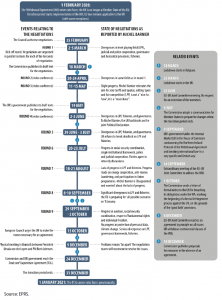Entering into force on 1 February 2020, the WA provided for a ‘transition period’ during which, although no longer an EU Member State, EU law applied to the UK (with some exceptions), and allowed for EU UK negotiations on their future partnership to take place. The WA settled issues associated with the UK withdrawal from the EU. In particular, it preserved the essential rights of EU citizens and their families residing in the UK at the time of the end of the transition, as well as many rights for UK citizens resident in the EU, and established that the UK will honour its share of the financing of the EU’s liabilities incurred before the end of the transition. In addition, the Protocol on Ireland/Northern Ireland declares that Northern Ireland is part of the customs territory of the UK, while goods from Northern Ireland continue to benefit from tariff-free access to the EU. Furthermore, the WA was accompanied by the joint (non-binding) Political Declaration, which set out the objectives for the new EU UK relationship. The provisions of the Political Declaration in relation to the objectives of the economic partnership affirmed that the parties agree to develop an ambitious, wide-ranging and balanced economic partnership. The aim was for the latter to be comprehensive, including a free trade agreement (FTA), as well as sectoral cooperation, and supported by provisions ensuring a level playing field. The partnership was to aim at facilitating trade and investment to the extent possible, while respecting the integrity of the EU single market and the customs union, the UK’s internal market, and recognising the future development of the UK’s independent trade policy.
The Council adopted a decision authorising the opening of negotiations on 25 February 2020, which began with the first round on 2 March 2020. The negotiations were led by Michel Barnier on behalf of the EU, and David Frost on behalf of the UK. In February 2020, the EU and the UK announced their respective approaches and objectives for the negotiations. The UK’s approach diverged with respect to the Political Declaration, as it promoted the adoption of separate agreements in the respective areas. In contrast, the Council directives for the negotiations supported the approach of reaching a single overarching agreement. For the EU, separate agreements would result in the proliferation of instances governing each agreement. In addition, the areas covered by negotiations are intertwined and, for the EU, should be treated jointly, allowing for cross-area retaliation if necessary.
Nine rounds of negotiations, covering eleven areas, were held between March and October 2020, with negotiations intensifying thereafter. The European Commission, on behalf of the EU, and the UK published their negotiating text proposals in March and May 2020 respectively. The UK published nine draft texts separating the areas, among which a Comprehensive Free Trade Agreement (CFTA) and a Fisheries Framework Agreement. Conversely, the EU issued a single draft text, entitled Agreement on the New Partnership with the United Kingdom (ANP). In June 2020, despite outstanding divergent positions on major areas, the UK declined to request an extension to the transition period, possible under the WA, asserting that the transition would expire on 31 December 2020. The parties therefore intensified negotiations, meeting daily in December 2020. While several issues surfaced during the negotiations, three major questions were repeatedly reported by the parties as being far from settled: the level playing field (i.e. sufficient regulatory convergence in specific domains), fisheries, and the governance of the agreement.








Be the first to write a comment.